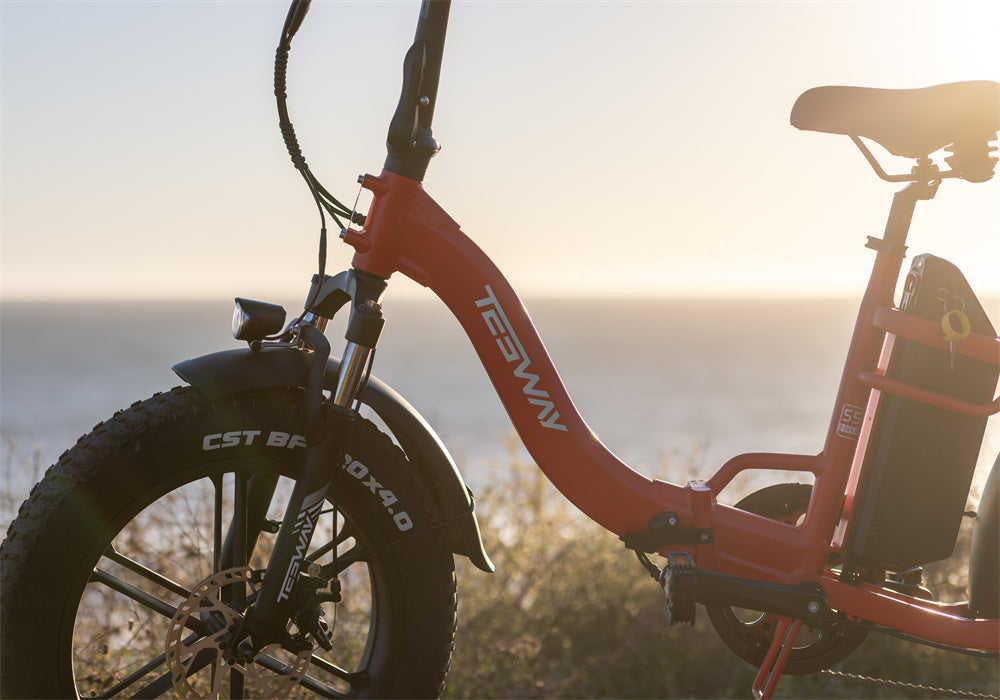You can absolutely put suspension on electric bike, and it’s increasingly common to see electric bikes equipped with either front suspension or full suspension systems.
The primary purpose of adding suspension to an Ebike is to absorb the shocks and vibrations that result from riding on uneven terrain, much like on a traditional bike 🚲.
It’s important to note that ebikes might require suspension systems that are specifically designed or tuned differently than those used on traditional bikes🚵.
Is It Good to Have Suspension on Bike
Having suspension on a bike, whether it’s a traditional bicycle or an eBike, offers numerous benefits that enhance the overall riding experience. The main advantages include:
Improved Comfort
Suspension systems are designed to absorb the bumps and vibrations from the road or trail, providing a smoother and more comfortable ride.
This is particularly beneficial for riders who frequently encounter rough terrain, as it reduces the strain on the rider’s body, especially the arms, shoulders, and lower back.
By cushioning the impact from uneven surfaces, suspension significantly reduces rider fatigue over long distances.
Better Control and Handling
Suspension enhances control and handling by keeping the wheels in contact with the ground, even on rough or uneven surfaces.
This is crucial for maintaining traction, which directly affects a rider’s ability to steer and control the bike.
Whether navigating tight corners, descending steep slopes, or riding on loose surfaces, a good suspension system ensures that the bike remains stable and responsive to the rider’s inputs.
SEE ALSO Suspension Makes for Smooth Ebike Riding
Enhanced Safety
A bike equipped with suspension is generally safer to ride, especially in challenging conditions.
The suspension helps to absorb unexpected impacts, such as hitting a pothole or rock, which could otherwise cause a loss of control.
By smoothing out these impacts, suspension reduces the risk of accidents, making it a valuable feature for both casual and serious riders.
Increased Speed and Efficiency
Suspension systems can also contribute to increased speed and efficiency, particularly in off-road conditions.
By smoothing out the ride, suspension allows riders to maintain higher speeds over rough terrain without being slowed down by bumps and jolts.
This can lead to faster overall travel times and a more enjoyable riding experience.

Coil vs Air Suspension
On an electric bike, there are primarily two types of suspension systems: coil suspension and air suspension.
Coil Suspension
Coil suspension consists of a metal coil spring combined with a damper, typically filled with oil, that controls the rebound and compression of the spring.
The coil spring is responsible for absorbing the shocks and impacts from the terrain, while the damper regulates how quickly the spring compresses and rebounds, ensuring a controlled and stable ride.
The coil spring in this system compresses when the bike encounters a bump or rough surface, absorbing the energy from the impact.
The damper then slows down the rebound of the spring, preventing it from bouncing back too quickly.
This combination provides consistent performance, especially in rugged terrains, where predictability and durability are crucial.
Components
- Coil Spring: The primary component that absorbs shocks.
- Damper: Filled with oil, it controls the speed at which the spring compresses and rebounds, ensuring a smooth ride.
- Preload Adjuster: Allows riders to adjust the initial tension of the spring to suit their weight and riding style.
💡 How to Refill Oil in Your Coil Suspension
Over time, the oil in the damper of a coil suspension can degrade or leak, which may affect its performance. Here’s a simple guide on how to refill the oil:
-
Preparation: Start by removing the coil shock from your eBike according to the manufacturer’s instructions. You’ll need a clean workspace, the correct oil type recommended by the manufacturer, and tools such as a wrench and a syringe.
-
Disassembly: Carefully disassemble the shock unit. This typically involves unscrewing the top cap or removing the coil spring to access the damper. Be cautious to keep track of all components and their order.
-
Drain Old Oil: If there’s any remaining oil in the damper, drain it out completely. You may need to pump the damper gently to remove all the old oil.
-
Refill with Fresh Oil: Using a syringe, fill the damper with the recommended type and amount of oil. Be sure to avoid introducing any air bubbles into the system, as this can affect performance.
-
Reassemble: Carefully reassemble the shock, ensuring all seals and components are properly aligned and tightened. Reinstall the coil shock onto your eBike.
-
Test: Once everything is reassembled, test the suspension to ensure it’s working smoothly and effectively. You may need to fine-tune the settings based on your riding preferences.
Pros:
-
Durability: Coil suspension is extremely durable and can withstand heavy use in challenging terrains.
-
Consistent Performance: Unlike air suspension, which can change with temperature and altitude, coil suspension provides consistent performance regardless of environmental conditions.
-
Less Maintenance: Coil suspension systems typically require less maintenance, as they don’t have air seals that can wear out over time.
-
Weight: Coil suspension is generally heavier, which can be a drawback for riders who prioritize a lightweight bike.
- Less Adjustability: While you can adjust the preload on a coil spring, it doesn’t offer the same level of fine-tuning as air suspension.
Air Suspension
Air suspension utilizes air pressure in a sealed chamber instead of a coil spring to absorb shocks.
This system also includes a damper, which controls the rebound and compression similar to the coil system.
The air suspension system is lighter and more adjustable, making it popular among riders who prefer customization and weight savings.
Air suspension works by compressing air within a sealed chamber when the bike encounters a bump.
The compressed air acts as a spring, absorbing the energy from the impact. The damper then controls how quickly the air chamber returns to its original state, preventing excessive bounce.
Riders can adjust the air pressure to fine-tune the suspension's stiffness, making it adaptable to various riding conditions and rider preferences.
Components
- Air Chamber: The primary component where air is compressed to absorb shocks.
- Damper: Controls the compression and rebound, similar to coil suspension, ensuring a smooth ride.
- Air Valve: Allows riders to adjust the air pressure within the chamber to customize the ride feel.
- Rebound and Compression Adjusters: Fine-tune the response of the suspension for different terrains and riding styles.
Pros:
-
Lightweight: Air suspension is significantly lighter than coil suspension, making it ideal for riders who want to keep their eBike as light as possible.
-
Adjustability: Air suspension allows for a wide range of adjustments, including air pressure, compression, and rebound settings, enabling riders to customize their ride feel.
- Versatility: Air suspension can be easily tuned for different riding conditions and rider weights, making it a versatile option for various types of terrain.
Cons:
-
Maintenance: Air suspension requires more maintenance, as the seals can wear out and the system can lose air pressure over time.
-
Performance Variability: Air suspension can be affected by changes in temperature and altitude, which can alter its performance if not regularly adjusted.
FAQs
Does adding suspension make my eBike heavier?
Adding suspension, particularly full suspension systems, can increase the overall weight of your eBike.
While this additional weight might slightly impact handling and battery efficiency, the benefits of improved comfort, control, and safety often outweigh the drawbacks.
Riders focused on weight might prefer air suspension systems, which are generally lighter than coil suspension.
Can suspension improve my eBike’s resale value?
Yes, having a well-maintained suspension system on your eBike can potentially increase its resale value.
Buyers often look for features that enhance comfort and control, and a bike with good suspension is likely to be more attractive to prospective buyers.
Regular maintenance and documentation of any upgrades or servicing can further boost the value.
Is suspension necessary for city commuting on an eBike?
While not strictly necessary, suspension can significantly improve the comfort of city commuting on an eBike, particularly if you encounter uneven pavement, potholes, or curbs.
Front suspension, in particular, can be a worthwhile addition for urban riders who want to smooth out their daily commute.







Share:
Ebike Battery | Should You Charge to 80% or 100%?
What Are the Different Types of E-bike Connectors